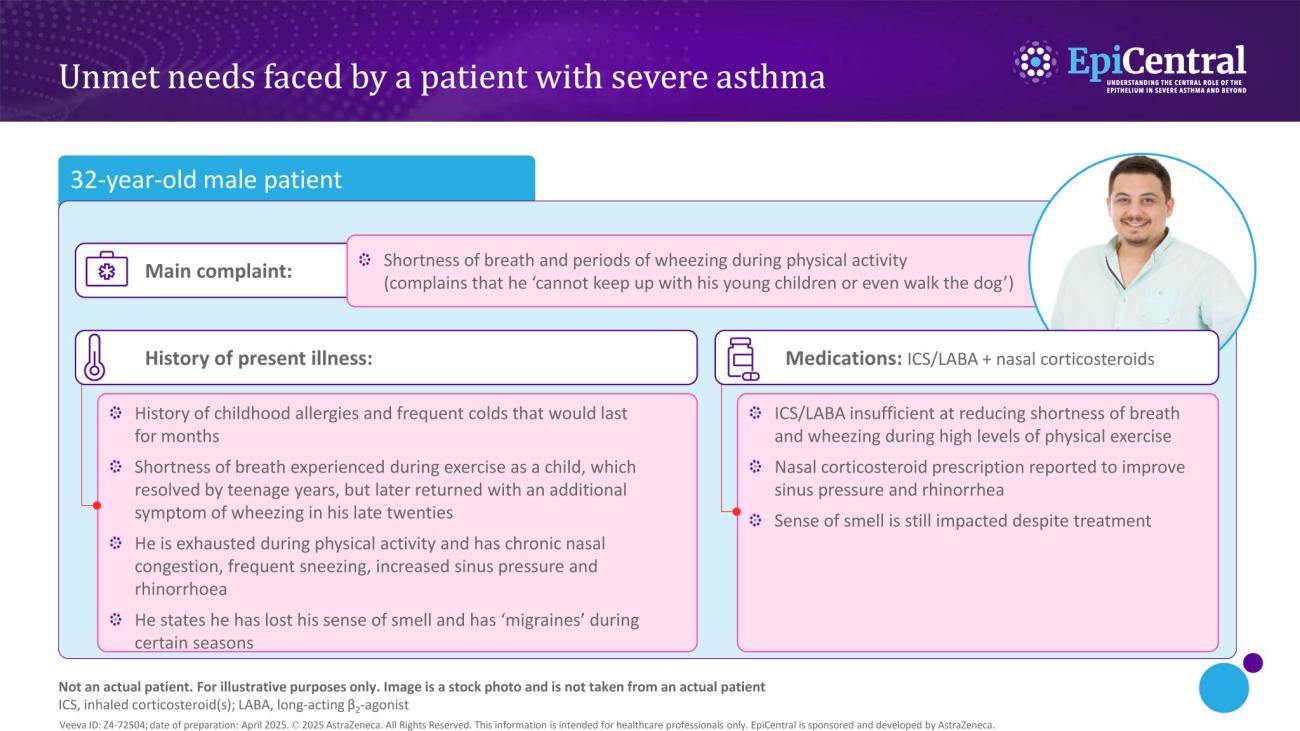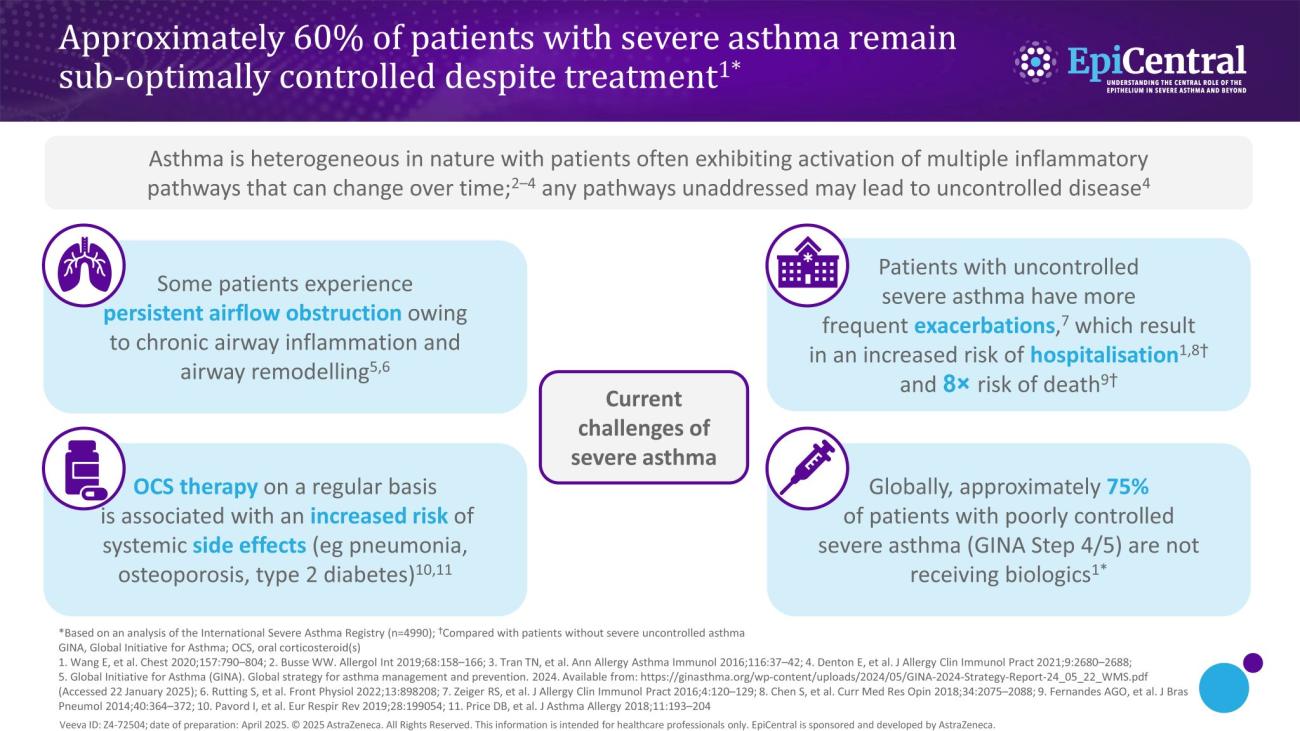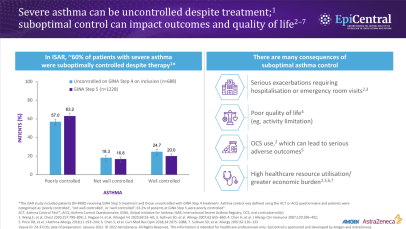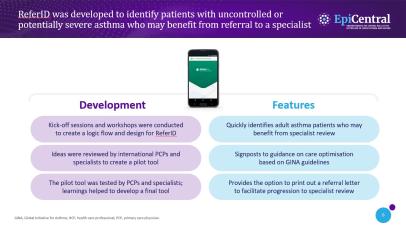References
1. Caminati M, et al. J Asthma Allergy. 2021;14:457–466;
2. Global Asthma Network. Int J Tuberc Lung Dis. 2022;26(Suppl. 1):1–104;
3. Rogliani P, et al. Pulm Ther. 2020;6:47–66;
4. Global Initiative for Asthma (GINA). Global strategy for asthma management and prevention. 2024. Available from: https://ginasthma.org/wp-content/uploads/2024/05/GINA-2024-Strategy-Report-24_05_22_WMS.pdf (Accessed 29 May 2025);
5. Blakey JD, et al. BMJ Open. 2019;9:e031740; 6. Price D, et al. J Asthma Allergy. 2017;10:209–223; 7. Hardtstock F, et al. J Asthma. 2023;60:1280–1289; 8. Castillo JR, et al. J Allergy Clin Immunol Pract. 2017;5:918–927;
9. Murphy KR, et al. J Allergy Clin Immunol Pract. 2020;8:2263–2274;
10. Beuther DA, et al. J Allergy Clin Immunol Pract. 2022;10:3204–3212;
11. Dhruve H, et al. Thorax. 2023;78(Suppl. 4):A66 (Abstract);
12. Charriot J, et al. Eur Respir Rev. 2016;25:77–92;
13. Zervas E, et al. ERJ Open Res. 2018;4:00125–02017;
14. Djukanovic R, et al. Eur Respir J. 2018;52:1801671;
15. Wang E, et al. Chest. 2020;157:790–804;
16. Sadatsafavi M, et al. Can Respir J. 2010;17:74–80;
17. Suruki RY, et al. BMC Pulm Med. 2017;17:74;
18. Mayers I, et al. Eur Respir J. 2022;60(Suppl. 66):2306 (Abstract);
19. Halner A, et al. PLoS One. 2021;16:e0254425;
20. Chen S, et al. Curr Med Res Opin. 2020;36:1897–1911;
21. Nunes C, et al. Asthma Res Pract. 2017;3:1;
22. Nissen F, et al. Br J Gen Pr. 2018;68:e775–e782;
23. Soong W, et al. Ann Allergy Asthma Immunol. 2020;125(5 Suppl.):S27 (Abstract P203);
24. Ambrose CS, et al. Pragmat Obs Res. 2020;11:77–90;
25. Jackson DJ, Bacharier LB. Ann Allergy Asthma Immunol. 2021;127:524–529;
26. Hellings PW, Steelant B. J Allergy Clin Immunol. 2020;145:1499–1509;
27. Rutting S, et al. Front Physiol. 2022;13:898208;
28. Pavord ID. Curr Opin Pulm Med. 2019;25:51–58;
29. Price DB, et al. J Asthma Allergy. 2018;11:193–204;
30. Chen H, et al. J Allergy Clin Immunol. 2007;120:396–402;
31. Stubbs MA, et al. J Asthma Allergy. 2021;14:1527–1537;
32. Busse WW, Kraft M. Eur Respir Rev. 2022;31:210176;
33. Chen S, et al. Curr Med Res Opin. 2018;34:2075–2088;
34. Usmani OS, Levy ML. NPJ Prim Care Respir Med. 2023;33:24;
35. Chung LP, et al. Respirology. 2020;25:161–172;
36. Papapostolou G, et al. Eur Clin Respir J. 2020;8:1856024;
37. Bleecker ER, et al. Am J Respir Crit Care Med. 2020;201:276–293;
38. Canonica GW, et al. World Allergy Organ J. 2019;12:100007;
39. Sweeney J, et al. Thorax. 2016;71:339–346;
40. Scelo G, et al. Ann Allergy Asthma Immunol. 2024;132:42–53;
41. Skov IR, et al. Eur Respir J. 2022;60:2103054;
42. Voorham J, et al. Allergy. 2019;74:273–283;
43. Bleecker ER, et al. World Allergy Organ J. 2022;15:100726;
44. Tran TN, et al. Ann Allergy Asthma Immunol. 2016;116:37–42;
45. Kupczyk M, et al. Allergy. 2014;69:1198–1204;
46. Canonica G. Biomarker relatability in the International Severe Asthma Network. Oral presentation at WAC, Lyon, France 12–14 December 2019 (Abstract OC35);
47. Heatley H, et al. Eur Respir J. 2019;54(Suppl. 63):PA2712 (Poster);
48. Menzies-Gow A, et al. J Allergy Clin Immunol. 2020;145:757–765;
49. Thomas D, et al. Eur Respir J. 2022;60:2102583.




